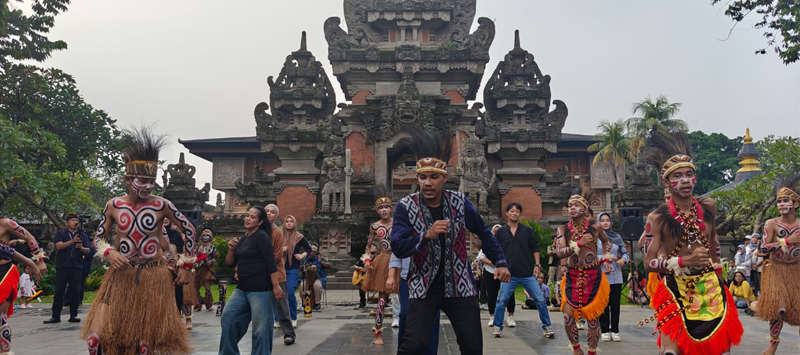
Exploring Jakarta: A Journey of Culture, Nature, and Urban Life
 |
Dr. Jaspreet Kaur Malhotra Chhabra Assistant Professor Department of Management Kristu Jayanti (Deemed to be University), Bengaluru |
Introduction
Jakarta, the bustling capital of Indonesia, is a city that effortlessly blends urban energy, cultural depth, and natural beauty. As the largest city in the country, it offers visitors a vivid glimpse into the nation’s rich heritage, modern lifestyle, and vibrant street life. This journey through Jakarta and its surroundings reveals experiences that are both memorable and immersive, from cultural landmarks to natural wonders.
Urban Life and Culture in Jakarta
Indonesia is the world’s 14th-largest country by area, spread across more than 17,000 islands, five of which — Java, Sumatra, Borneo (Kalimantan), Sulawesi, and Papua — form the major landmasses. The capital city, Jakarta, is situated on the island of Java and is home to over 10.6 million people within its city limits and more than 30 million in its greater metropolitan region, making it one of the most populous urban clusters in the world. As the industrial and business hub of the country, Jakarta draws workers from nearby cities every day, adding to its constant movement and density. The city has earned a reputation for heavy traffic — it is reasonably managed, but navigating it still demands patience. Together, these elements give Jakarta its unmistakable energy: a crowded, busy, and intensely alive atmosphere.
Jakarta is alive with Asian value systems and culture. Its people are warm and welcoming, reflecting the region's broader hospitality. The city hosts business centres, malls, shopping streets, and a variety of places for family outings — from parks and museums to mosques and cultural squares.
Malls, Restaurants, and Local Flavours
Among the major attractions are the malls and restaurants. Grand Indonesia, Plaza Indonesia, and Central Park stand out, each hosting numerous eateries. Asian, Italian, and local cuisines delight the taste buds. The most famous restaurant, Café Batavia (Old Batavia), offers a great ambience, delicious food, and a charming reminder of Dutch colonial architecture. Though the food at newer Batavia outlets is also pleasant, the original remains special. Café Batavia is situated at Batavia Square, a public space where people gather for celebrations. Lined with street performers, the square is illuminated with their vibrance. Local performances, especially during weekends and public holidays, draw large crowds.
Marine and Wildlife Experiences
Ancol provides another vibrant experience. The aquarium features a diverse array of exotic fish, and the curated displays and interactive performances by the staff bring the space to life. Nearby, the bird sanctuary offers close encounters with parakeets in several colours, peacocks, and other birds — reminiscent of Jurong Bird Park, though smaller in scale yet equally delightful. Feeding the ostriches was a first-time experience — they threw the feed down with strong pecks, one appearing particularly clever.
On the way to the dolphin show, a llama — an animal from South America — was observed for the first time. Dolphin Avenue has a unique vibe; the crowd is comprised of many women and children, all excited to witness the dolphins. The dolphin show lived up to expectations — the splashes, the touch when they rose from the water to be patted by the audience — truly a delight. In another arena, otters and seals enchanted the crowd.
Cultural Immersion at Mini Indonesia
Mini Indonesia (Taman Mini Indonesia Indah) offers a comprehensive cultural immersion experience. The large park represents the culture of all Indonesian islands, depicting housing, attire, dance forms, museums, aquariums, and more. A single day feels insufficient to explore fully. Ropeways, electric carts, double-seat bicycles, and scooters make travel across the park scenic and comfortable. Stores for food and crafts enhance the experience, offering moments of rest and interaction.
Natural Wonders: Kawah Putih and Rengganis Bridge
Kawah Putih, a volcanic crater located approximately 150 km from Jakarta, offers a dramatic natural experience. As the hills are ascended, the weather turns cooler, carrying the aroma of sulphur. The turquoise-blue crater lake is gorgeous, though visitors are advised not to stay too long due to fumes. Nearby, tea plantations and strawberry farms add a refreshing touch to the scenery. Pinisi — a ship-themed restaurant — offers a variety of tasty dishes and recreational activities, including ziplining and go-karting.
The journey continues to the Rengganis Suspension Bridge, often described as the longest in the ASEAN region at roughly 370 metres in length and suspended about 75 metres above the ground. The first crossing can feel intimidating, yet the return walk tends to feel easier once the initial fear subsides. On the far side, visitors enjoy hot springs and natural clay body masks, adding a soothing contrast to the thrill of the bridge.
Modern Transport and Local Landmarks
The driver, Warno, provided pleasant company and guidance throughout the journey. A huge fan of Arijit Singh, he played nearly all of his songs during the Kawah Putih drive, blending Indonesian scenery with familiar Indian melodies. Another driver, Dika, was similarly warm and welcoming.
The Whoosh Bullet Train, running at about 350 km per hour, is another must-experience attraction, with immaculately maintained stations. Locally, Monas (National Monument), prominent mosques and cathedrals, and the bustling Tanah Abang market are also worth visiting. Nearby Bandung, known as the “Paris of Java,” provides a contrasting urban experience.
Jakarta and Java together offer far more than any single trip can cover. There is always something to explore, taste, observe, and wonder at. The city is truly a place to shop, eat, and experience the layered charm of Asia in motion, making every visit a memorable journey through culture, nature, and urban life.